 |
surfresearch.com.au
slsaa : surf in australia, 1939 |
| home | catalogue | history | references | appendix |
|
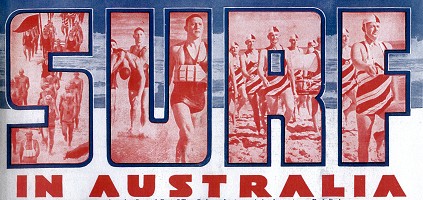
The Manly Council,
Pt. Jackson Company, and the Association's local organisers are leaving
nothing undone to arouse the interest of the general public.
Films of surf
work and play will be shown prior to the carnival date, and, the thrills
of the boat races, etc., included in these films, can be seen as actualities
at the carnival.
To win through
the preliminary heats to the championship events requires months of training
and perseverance.
All those partaking
are genuine stars in their own particular sphere, but the element of chance
gives any competitor an opportunity to win.
Almost overshadowing
the championship carnival in current interest is the proposed visit of
swimmers, surf board riders and a boat crew to Honolulu in July.
Perhaps the San
Francisco Exposition thereafter.
Those winners
of our championships this month might, therefore, be in line for a bigger
trophy- by way of a visit abroad- than ever offered before.
This alone should
urge them to greater efforts, if possible, on 18th March.
It is very rare
for these events to be won more than once, so that old champions may fall
and new champions arise.
Juniors of last
year become seniors of this year, and we have often before seen youth victorious
over experience.
Whilst New Zealand,
South Australian, West Australian and Tasmanian teams will be absent this
year, there is no reason why this month's carnival should not be one of
the greatest ever.
Many of the surfing
public give nothing to the surf life-saving movement, but here is an opportunity
to contrIbute a modest florin by supporting the national service wIth their
presence at the carnival.
ALOHA
| Volume 3 Number
8.
April 1, 1939, page 14. HOLCOMBE NOMINATED FOR HAWAII Holcombe is acknowledged by all familiar with surf carnivals to be the greatest exponent of the surfoplane seen since the inception of this sport, and over a period of years has strung together an almost unbelievable sequence of victories. In presenting
himself for selection, Holcombe has more than one avenue to exploit in
his favour, for he can undisputedly lay claim to being one of the finest
all-rounders of present-day surfing.
Image right:
|
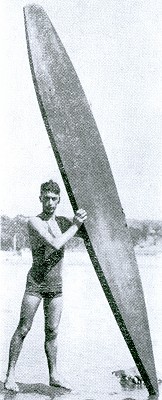 |
Proposed
Programnle by Hawaiiall Pacific Aquatic, Carnival Committee
JULY 6-24, 1939
Featuring Australia's
Swimmers and Life-Savers Against Hawaii's Best in Honolulu
July 5 (Wednesday).-
Australian team arrives in Honolulu.
Committee intends
to have a parade through town, finishing at the Governor's Office, where
the
Australian team
will be presented to our Governor.
From Governor's
Office team will go to Pali, then to Waimanalo, around Koko Head, and back
to Army and Navy Y, where team will make their headquarters.
July 6 (Thursday).-
K.G.M.B. broadcast, evening, at Station.
July 7 (Friday).-
Australian team will be guests at representatives' club luncheon.
July 8 (Saturday).-
Australian team will visit pineapple cannery and sugar mill.
July 9 (Sunday).-
Australian team will give life-saving exhibition at Koko Head Beach, 3
p.m.
Public cordially
invited.
July 10 (Monday).-
Parade through town by Australian team, with lifeboats and life-saving
apparatus. Local teams will also co-operate.
July 11 (Tuesday).-
Australian team will be guests of Al Karasick Wrestling Show at Civic Auditorium.
July 12 (Wednesday).-
First night swimming meet at Natatorium, Waikiki, featuring Australia's
champion swimmer, Biddulph, against Hawaii's best, Nakama and Hirose.
Programme of
events as follows:-
1. Diving.- Men,
Open.
2, 50 Yards Freestyle.-
Boys under 13 years of age.
3. 50 Yards Freestyle.-
Girls under 13 years of age.
4. 100 Yards
Freestyle.- Men, Novice.
5. 880 Yards
Freestyle.- Men, Open.
6. 100 Yards
Freestyle.- Women, Open.
7. 50 Yards Backstroke.-
Boys under 13 yrs. of age.
8. 50 Yards Backstroke.-
Girls under 13 yrs. of age.
9. 150 Yards
Backstroke.- Men, Open.
10. 330 Yards
Medley Relay.- Men, Novice.
11. 100 Yards
Freestyle.- Men, Open.
12. 440 Yards
RelaY.- Women, Novice.
13, 440 Yards
Relay.- Men, Novice.
14. 100 Yards
Surfboard Race.-Men, Open.
15. 330 Yards
Medley Relay.- Men, Open.
July 13 (ThursdaY).-
Free morning for Australian team to do shopping.
KGMB Broadcast
in evening at Station.
July 14 (Friday).-Second
night swimming meet, Natatorium, Waikiki.
Programme of
events as follows:-
1. Diving Tower.-
Men, Open.
2. 50 Yards Breaststroke.-
Boys under 13 yrs. of age.
3. 50 Yards Breaststroke.-
Girls under 13 yrs, of age.
4. 100 Yards
Freestyle.- Women, Novice.
5. 220 Yards
Freestyle.- Men, Open.
6. 100 Yards
Breaststroke.- Women, Open.
7. 220 Yards
Freestyle.- Men, Novice.
8. 330 Yards
Medley Relay.- Women, Novice.
9. 220 Yards
Breaststroke.- Men, Open. iJ 10. 100 Yards Backstroke.-Men, Novice.
11. 440 Yards
Freestyle.- Men, Open.
12. 100 Yards
Breaststroke.- Men, Novice.
13. 440 Yards
Relay.- Women, Open. E 14. 440 Yards Relay.-Men, Open. b
July 15 (Saturday).-
Free to Australian team.
July 16 (Sunday).-
Lifeboat, canoe, surf board, ski and outboard motor regatta at Ala Moana
Canal in front of a Moana Park, 8.30 a.m.
Programme of
events as follows:-
1. Outboard speed
boat race- course to be laid out.
2. 9 a.m.- Canoe
6 paddle Jr. Men - 1 mile.
3. Inter-Island
lifeboat race- 1 mile (sailor only).
4. Hawaiian surf
board race, 1 mile (board must be 12 ft., at least 60 lbs., 12 inches width
at stern).
5. Junior 6 oar
sliding seat barge race- 1 mile.
6. Canoe 6 paddle
senior race- 1 mile.
7. Freshman 6
oar sliding seat barge race- 1 mile.
8. Australian
ski paddling race- 1 mile- Hawaii v. Australia.
9. Surf board
relay-women (8 to team)-1 mile straight course.
10. Senior 6
oar sliding seat barge race- 1 mile.
11. Australian
lifeboat race- Hawaii v. Australia.
12. Canoe 6 paddle,
boys under 16 years- 1 mile.
13. Surf board
relay (8 men to team)- 1 mile straight course.
14. Finish of
Pearl Harbour Yacht Club star boat races in front of Ala Moana Yacht Club.
Finish 12.30
noon.
July 17 (Monday).-
Free to Australian team.
July 18 (Tuesday).-
Australian team guests of Al Irasick Wrestling Show at Civic Auditorium.
July 19 (Wednesday).-
Swimming meet at Punahou Tank.
Programme of
events as follows:-
1. 150 Yards
Backstroke.- Men, Open.
2. 220 Yards
Freestyle.- Men, Open.
3. Diving 3 Metre.-
Men, Open.
4. 300 Yards
Medley, Individual.- Men, Open.
5. 100 Yards
Freestyle.- Men, Open.
6. 220 Yards
Breaststroke.- Men, Open.
7. 440 Yards
Relay.- Men, Novice.
8. 400 Yards
Relay.- Men, Open.
9. 400 Yards
Relay.- Women, Open.
10. 500 Yards
Freestyle.- Men, Open.
11. 300 Yards
Medley Relay.- Men, Open.
July 20 (Thursday),-
Morning free to Australian team.
KGMB broadcast
at station, evening.
July 21 (Friday).-
Australian team visit to Pearl Harbour and Schofield.
July 22 (Saturday).-
Life-saving exhibition and sport pogramme in front of Ala Moana Hotel,
3 p.m. Free to public.
Programme of
events as follows:-
1. Life-Saving
Rescue Race- Australia v. Hawaii.
2. Australian
Lifeboat Race through Surf.
3. 100 Yards
Footrace on Sand Beach.
4. Surf Board
Race through Surf.
5. 400 Yards
Relay Race on Sand Beach.
July 23 (Sunday).-Trip
around the islands and wind-up with a luau.
July 24 (Monday).-Team
returns to Australia.
Note.-The Associated
Students of the University of Hawaii will see that all visiting Australian
athletes will given instructions in the fundamentals of basketball played
in American colleges.
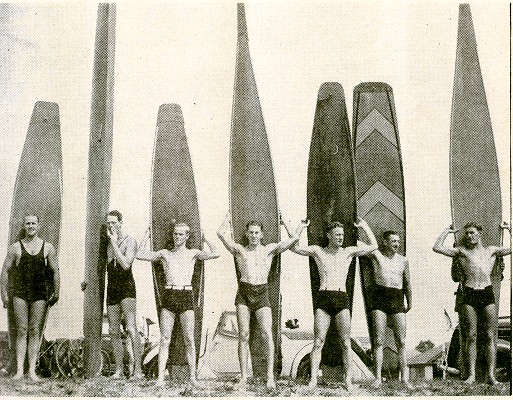 |
From left:
- Block courtesy
of
|
| Volume 3 Number
9.
May 1, 1939, page 8. Newcastle
Image right:
|
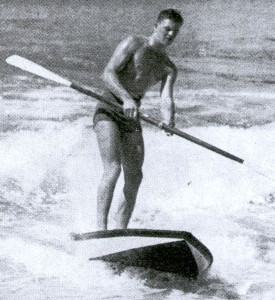 |
Never since Duke
Kahanamoku visited Sydney, way back in 1915, has there been seen local
interest in surfboard riding as during the past few months.
The surf ski,
invented by one of our own members, had come into prominence and had threatened
to practically extinguish the board until the visit to Honolulu was first
mooted.
If annual visits
between Hawaii and Australia can be sustained, the popularity of the board
might again become paramount.
It is pleasing
to see rescue and resuscitation competitions and surf boat races included
in the programme of events, for these open up avenues for others than board
riders to travel and compete, providing greater interest for all.
We anticipate
that the photographer with the team will procure for the Association moving
films in colour which those left behind may ultimately see and envy.
In the not so
far disant future we hope to be able to send a team to South Africa, which
would be another tep towards spreading our work around the globe.
Such visits,
however, are limited by the financial position of the Association, unless
outside enterprise comes to our assistance, as it has done for the present
tour.
The success or
otherwise of the visit now in progress will no doubt largely influence
any future journeys overseas.
It was pleasing
at the official send-off to the members of the chosen band to see so many
members of the early days present, whose pioneering work has been chiefly
responsible for the building up of such an impressive and extensive organisation
as surf life-saving is to-day.
Equally pleasing
it was to have representatives of the Amateur Swimming Association present,
to cement the bond that must exist for the two bodies of swimmers to amicably
continue to administrate the laws of swimming competitions in their respective
spheres.
Apart from the
competitive side of the trip, there exists in the minds of most of us a
romantic vision of hula girls, guitars, ukuleles, moonlight nights and
summer breezes.
These things
will appeal to our sons of the surf.
May they be as
real as they appear, and that our boys will not return disappointed with
the reputed charm of the Islands.
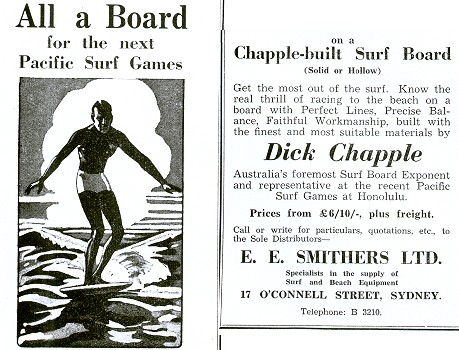 |
Note that the distributors,
Image adjusted
|
Of particular
interest is the fact that this firm has concluded arrangements with Dick
Chapple, Australia's foremost surfboard exponent and representative at
the recent Pacific Surf Games at Honolulu, to supply hollow and solid surfboards
for the coming season.
Whilst in Honolulu,
Dick Chapple made an intensive study of Hawaiian surf-board construction.
The surfboards
he is producing for the coming 1939-40 season include many new features
and designs incorporating the latest Hawaiian and American ideas.
Chapple has already
proved the excellence of his surfboards by his sterling performances against
the world's leading exponents of surfboard riding, and the additional knowledge
he has acquired will make his surf- boards outstanding on Australian beaches.
Mr. Jack Cameron.
Manager-Instructor of the Australian Surf Teams and Chief Superintendent
of Examiners and Instructor of the S.L.S.A., says: "... As a craftsman
in the manufacture of surfboards, I consider Dick Chapple capable of producing
the finest boards in Australia, and indeed equal in performance to any
I have seen overseas."
Our surfmen bring back with them memories of a sincere and spontaneous American friendship. They leave behind a fine reputation for sportsmanship and skill.
The publicity
value of the tour is incalculable.
It has introduced
Americans to a unique and spectacular branch of Australian athletics.
Made Them A ware of Australia
American tourists
who never thought of going beyond Honolulu have become aware of a great
English-speaking continent not so very far away.
Aware, too, that
it breeds not only kangaroos and koalas, but fine sportsmen with a unique
system of life-saving.
Early next year
there will be a "return visit" of American surfmen.
It all means
a strengthening of the bonds between the two Pacific democracies at a time
when there is urgent need of a united democratic front.
Our Destiny in the Pacific
The shrinking
of the Pacific is a matter of the first importance to Australia.
Our destiny lies
in this ocean, as America's does.
That is why we
acclaim the first Pacific Surf Games so enthusiastically.
That is why the
"Daily Telegraph" - with the Australian National Travel Association- sponsored
these games and financed them.
It cost us £2,000
to send the surfmen to Honolulu.
We think the
money was very well spent.
Government Should Have Done It
Extracts
from Captain's Report of Pacific Surf Games,
Honolulu,
1939.
By
J. Cameron
The team was given a rousing send-off by relatives, officers and supporters of the Association when the "Monterey" sailed from Darling Harbour on 23rd June at 11 a.m.
On Monday morning
we berthed at Auckland at 7 a.m., being met by press and Auckland Association
officials in the persons of Dr. Pettit, President; A. Gardiner, Chairman
of Committees; Miss Usmar, Hon. Secretary; and Mr. Miller, Secretary of
the New Zealand A.S.A.
We were conducted
to the tepid baths, where all the team had a good workout.
Biddulph gave
an exhibition swim to promising members of the N.Z.A.S.A.
The boat crew
were able to secure the loan of a four from the Auckland Rowing Club, enabling
them to spend the morning rowing, while the board men had their boards
lowered over the side into the harbour and had considerable paddling practice,
in spite of the very low temperature.
Later followed
a civic reception and lunch by Sir Ernest Davis, Lord Mayor of Auckland.
After lunch we
were taken on a scenic tour of Auckland and surrounding districts.
On leaving Auckland we met Lotte Lehman and Bernice Clare and became acquainted with Larry Adler, who joined our physical exercise class before breakfast and walks round the deck, and accompanied the team on the piano in our team songs.
On 30th June we
arrived at Suva at 7 a.m., to receive a hearty reception from officials
of the Royal Life Saving Society, Mr. S. Baker (Secretary), F. Midson (Hon.
Secretary Hockey Umpires Association), Mr. C. Stanton (President, Athletic
Club), and Mr. A. Barker (President of R.L.S.S.).
The Fiji Association
had arranged for a fleet of cars to convey us to beautiful scenic spots.
I lunched with
the President at the Grand Pacific Hotel, and at 2.30 all the school children
were assembled at the local baths for an exhibition swim by Biddulph and
other members of the team.
At the conclusion
a water polo match was played against the schools, resulting in a win for
our representatives by 7 goals to 2. We departed from Suva at 5 p.m.
Crossing the international
date line we had two Thursdays.
Arrived Pago
Pago on 31st at 8 a.m.
On reaching the
wharf, the team was met by naval officers who arranged dressing accommodation
and the use of the swimming bath.
We were warned
not to use the bath steps and turning boards owing to the presence of the
fungus growth, and advised to swim in the open water.
This is the accepted
practice here, and in a short time the men were swimming around the ship.
The passengers
took great interest and began tossing coins in the water to them.
Our boys soon
demonstrated their ability to re- trieve same, and the total monies collected
were
donated to the
Seamen's Fund.
On 1st July the
Matson Co. tendered a dinner on board in honour of the team, and prepared
special menus in which the whole of the team's names appeared.
On the run from
Pago to Honolulu we had five days of ship life without interruption, and
excellent training was carried out.
On arrival off
Diamond Head on Wednesday, 5th July, we were first met by the two Australian
surf boats, manned by Hawaiians and Americans.
Then came Duke
Kahanamoku in a Customs cutter, accompanied by John Williams, Secretary
of the Executive Committee, and Don Watson, Committeeman.
After immigration formalities, these gentlemen boarded and presented leis to every member of the team.
We were greeted at the dock by a Committee headed by Theodore Searle (Secretary, A.A.U.), Dad Center, Al Karasic, and a group of girls from the University of Hawaii, who presented each member with a lei and a lauhala hat.
After landing, we were escorted by the police in a parade through the business section of the city, headed by the Royal Hawaiian Band of 60 performers.
Then to the capital,
where we were received by the Acting Governor, Chas. M. Hite.
From there to
the City Hall and welcomed by the Mayor, Chas. S. Crane, and other executives.
Their welcomes
were a splendid tribute to our Association, for the Governor and Mayor
fraternised with our men for a considerable time and gave high praise for
our work.
Hawaiian music
and dancing entertained us at the City Hall.
From there we
journeyed to the Pali to see the magnificent view of the island, and receiving
bunches of bananas, cocoanuts and pawpaw, later returning to the city,
where we were quartered at the Army and Navy Y.M.C.A.
The team dined at the Y.M.C.A., while Messrs. Wynter, Hay and myself were guests of representatives of the three sponsors of the Pacific Aquatic Carnival, the Kamaaina Beach Combers, Hui, the Star Bulletin, and ...
Page 3
... the associated
students of the University, at the Cahu Country Club.
The complete
programme for the carnivals was submitted to us for discussion and approval.
After meeting
we returned to Army and Navy Y.M.C.A. to attend a meeting of Australian
residents of Honolulu, who gave us an enthusiastic welcome and issued many
invitations to functions.
In the evening many members of the team were the guests of Mr. and Mrs. Jim Gandry, Australian residents, at their home, and a most enjoyable night was spent.
At 8 a.m. the
next day the team was picked up at our hostel by Hawaiian Pineapple Company
officials and conveyed to the pineapple plantation for an inspection of
Hawaii's second industry, employing 6,000 workers.
The plantation
was in full swing, and in 24 hours 3,000 tins of pineapple are removed
to the cannery by 25 large motor trucks.
At the entrance
to the plantation, which is approximately 25 miles square, drivers report
to the office and are directed to the part requiring their services.
The pickers,
who are mostly Japanese men and women, wear glasses and gloves for protection
against spikes and toil for 10 hours daily.
The pickers cut
the ripe fruit and lay it on the bushes, where it is picked up by an automatic
loader and packed in cases.
After inspection
we were entertained at luncheon at Kemos, afterwards passing through Schofield
Barracks and Wheeler Field aerodrome on our way to inspect the pineapple
cannery, recognised as the largest in the world.
The store-rooms
contain 100 million cans, the cafeteria accommodates 2,000 employees at
one sitting, machines peel and core 90 pines a minute, machines label 1,400
tins per minute, and one day's work is 3 1/2 million tins.
There is absolutely
no wastage- bran is obtained from the skins and fuel from the cores.
The team had the
pleasure of being made honorary members of the famous Outrigger Canoe Club.
Water conditions were pleasant, because water temperatures here range from
66 degrees to 82, and the weather is never colder than 56 nor warmer than
88.
The team had
a free evening, and Wynter, Hay and self gave broadcasts from Station KGMB.
Friday, 7th
July.-The morning was spent training at the beach, and at mid-day we
were guests of the Representatives Club at the Alexander Young Hotel.
The team was
introduced individually, and I addressed the luncheon on the Association's
doings and surfing in general.
Later the team
visited the children's play-grounds, under the direction of Arthur Powlison
(Superintendent of Recreation Commission).
These play-grounds
number 78 in all, controlled by a Commission appointed by the Territorial
Government.
The idea is to
protect Hawaiian children, and the grounds have beautifully-kept lawns,
gardens, swings and gymnasiums, and in many cases swimming pools.
At 8 p.m. a curfew
is sounded, and children under the age of 15 years unattended must be indoors.
While team was inspecting playgrounds, Theodore Searle and myself inspected
the Makapun Beach to see if it was suitable for a demonstration, which
was to be held on the Sunday.
Saturday, 8th
July.-Official visit to the University of Hawaii, and we were greatly
impressed with layout; each subject has own building in spacious grounds.
In the afternoon
assisted in broadcast to the mainland carried out by Station KGMB from
the Lanai of the Moana Hotel and later from in the surf.
Entertained that
evening at Hawaiian Rowing Club dance at Dreier Manor.
Sunday, 9th
July.-The team made its first public appearance at 3 p.m. at Makapun,
giving demonstration of R. and R. with details, followed by exhibitions
of belt and surf racing, surf board riding and surf boat work.
This exhibition
amazed a crowd of 15,000 with the precision of the R. and R. drill, and
much favourable comment was heard on all sides.
Later, when the
boat cracked a wave, the crowd went wild with excitement and kept asking
the crew to give further exhibitions, which they did, and were roundly
applauded by thousands lining the highway to Makapun.
Many cars were
parked over a mile from the beach.
Monday, 10th
July, found us guests of the Waimanalo sugar plantation in the morning.
Sugar is the
chief industry of the island, the annual yield being 1 1/4 million tons.
The combined
value of the sugar and pineapple industry is estimated at 100 million dollars.
Tuesday, 11th
July.-This day was free from official functions, and the morning and
afternoon was spent training at Waikiki beach until six o'clock.
In the evening
we were the guests of Mr. A. Karasic at the Stadium, where we received
a very hearty welcome from the wrestling fans.
|
|
10-year-old champion swimmer of Hawaii |
Wednesday,
12th July.-After acknowledging the welcome at the Natatorium, the team
sang "Sons of the Surf," which was broadcast by Station KGMB.
The carnival
was well conducted, and in addition to a full swimming programme 5,000
spectators were entertained by a string orchestra, two brass bands and
many exhibitions of the Hula.
Robin Biddulph
swam third in the 800 metrs race, won by Nakama in Hawaiian record time,
and in the only other event we contested, the 400 metres relay, our team,
consisting of McKay, Doerner, Fitzgerald and Furey, was successful.
In the heats
of the 100 yards board race Morath and Chapple qualified for the final
by getting 1st and 3rd respectively in the 1st heat and Russell qualified
in the second heat, gaining 3rd place.
Thursday, 13th
July, was free from official functions, and all possible time was spent
at Waikiki training.
The team had
the pleasure of meeting Ginger Rogers and Ruby Keeler, and induced Ginger
to ride in the surf boat, which she enjoyed immensely.
Friday, 14th
July.-In order to aid the Chief of Police, Mr. W. A. Gabrielson, in
developing an Al police life-saving squad, the six most powerful swimmers
in the force were given demonstrations in R. and R. work and later were
drilled and coached in medallion work for several hours.
At the night
carnival Biddulph secured 3rd place in the 200 and 400 metres.
The relay team
secured second place in the 400 yards relay in opposition to the crack
Maui team, including Nakama and Hirose.
In the final
of the 100 yards board race Russell secured 3rd place and Boorman 4th place.
Page 4
Saturday, 15th
July.-Team met by police officers and driven in Black Maria to police
headquarters for an inspection, and also to screen our special surf film
to them.
The force was
greatly impressed with our work, and further demonstrations in R. and R.
were given in the City Armoury to the selected policemen and also to officers
of the army forces, who were also impressed.
After demonstration
several army officers spoke of happy associations with Anzacs in the Great
War.
After lunch we
journeyed to Waialua Beach, situated some 30 miles from Honolulu, on the
other side of the island, to demonstrate to officers and men of the Hawaiian
Army Recreation Office, the Waialua Agricultural Company and Community
Association.
The beach was
well attended by civilians and service men, and so well were our methods
received that there is every possibility of their adoption by the army.
After being entertained
at dinner at the Haliewa Hotel, the team returned to Honolulu.
Sunday, 16th
July.-Competed at Aquatic Carnival held Ala Moana Canal, starting at
8.30 a.m.
A crowd of about
3,000 watched the most complete and diversified regatta ever presented
in Honolulu.
On the programme
were canoe races, barge races, surf boat races, surf board competitions,
outboard motor races and swimming events.
Our crew triumphed
over the Territorial Beach patrol oarsman representing the island in the
3/4 mile surf boat race, which was the feature event of the regatta, in
the good time of 6 min. 57.7 sec. Australia won the surf board relay over
a mile in 10 min. 49.5 sec., thanks to the magnificent effort of Lou Morath,
who reduced a leeway of 40 yards to enable R. Russell to commence the last
lap with a lead of 5 yards.
Russell continued
the good work and won by 30 yards.
In the 3/4 mile
board race, J. May, of Honolulu, who had started under protest, won from
R. Russell and Dick Chapple, but was disqualified owing to irregularities
in his entry, and the race was awarded to R. Russell.
In the 1/2 mile
swimming race Biddup suceeded in gaining second place to K. Nakama after
swimming a very erratic course.
After the regatta
the team was entertained by the Rowing Association at Dreier Manor.
Monday, 17th
July.-After training at Waikiki the team visited the aquarium and later
visited the Bishop
museum, where
surprising interest was displayed in several early native surf boards,
native canoes, paddles, hollow log drums, and feather capes and helmets.
In the afternoon
we were guests of the Pistol Club at their indoor shooting gallery.
This club is
composed almost entirely of Customs Officers, and from their exhibitions
of target shooting there is no doubt of their ability as marksmen.
That evening the
team attended Punahou Tank for heats of championships and competed against
their combined water polo team.
The game resulted
in a drawn game, each scoring 4 goals, but the Hawaliians changed men as
soon as they became tired, and in all twelve men took to the water against
us.
Tuesday, 18th July.-Free day.
Wednesday,
19th July.-At Punahou, Biddulph secured second place in the 500 yards
open championship and fourth place in the 200 yards open.
The polo match
held at the conclusion of the carnival resulted in a victory for Australia
by 3 goals to 2.
Thursday, 20th
July, was spent at Waikiki having final preparations in march past
and rescue work for the final surf carnival on the Saturday.
By this time
the rescue team had been moulded into a magnificent combination, and it
was disappointing for them to receive no actual competition from the Hawaiians.
Friday, 21st
JuIy.-The morning was free from training and official functions, and
in the afternoon a visit was made to Pearl Harbour Naval Base.
The most in-
...
Page 5
... teresting feature was to inspect the rescue diving bell, the like of which was used in the Squalas disaster, and to witness an ascent by a diver in the 100 ft. diving tower, which is claimed to be the only one of its kind in the world.
Saturday, 22nd
July.-Our team concluded its Honolulu Pacific Games visit with a surf
carnival at Waikiki Beach in the afternoon, commencing at 3 p.m.
The Australian
style programme had to be curtailed, as it was impossible to hessian the
area and thousands of spectators overflowed on to the narrow beach, crowding
out the competitors. However, the team was greatly applauded when they
gave a characteristic march past display, a unique spectacle at Waikiki.
Then our rescue
and resuscitation squad, in giving a rescue display, which was explained
to the vast crowd through a megaphone by myself, drilled with machine-like
precision as the huge crowd fought for better vantage points.
After this exhibition
it became utterly impossible to clear the people from the beach, and the
only other beach event contested was a beach relay race, in which our men
were successful by a big margin.
The boat crew
succeeded in winning their race by the narrowest of margins after one of
the most exciting races I have ever witnessed.
With the exception
of the last 50 yards the Hawaiians were always in front, and only a super-human
effort on the part of the crew enabled them to win.
There were two
board races conducted, one an unrestricted race, in which Russell came
second, and a restricted race in which boards were drawn for, and Chapple
secured third position.
That evening the team were the guests of the University of Hawaii at a dance held at the University.
On Sunday,
23rd, we were assembled early at our headquarters and driven to Hanula,
situated on the other side of the island, for games and other sports, winding
up with a Luau, in other words an Hawaiian feast.
On arrival all
were tossed, fully clothed, into a small pond in front of the residence
and then given liquid refreshments.
After spending
the morning playing baseball, volley ball and Ameriann football, all had
to disrobe and enter the sea.
Those not adhering
to the custom were forcefully disrobed and flung into the sea.
Then followed
the feast, at which pig, chicken, Havlaiian Poi, raw fish and island fruits
were eaten with our fingers.
The function concluded after very many speakers had paid tribute to the magnificent record of the team and gifts commemorating their affiliation with our Association had been presented to me.
Monday, 24th July.-Mr. Wynter and myself dined with the Executive at lunch and the Australian flag was presented to the Committee for thc President of their Association.
When the hour
for departure arrived on Monday our hearts were sad at leaving sincere
and spontaneous American and Hawaiian friends.
Our final farewell
speeches were broadcast from the deck of the Monterey by station KGl\IIB.
Probably the most touching fare- well was when Paul Wolf and Bob Pirie,
swilnming champions, stripped on the wharf and, diving into the water;
swam a quarter of a mile to wave good-bye as
speeches were
broadcast from the deck of the Monterey by station KGMB.
Probably the
most touching farewell was when Paul Wolf and Bob Pirie, swimming champions,
stripped on the wharf and, diving into the water, swam a quarter of a mile
to wave good-bye as the ship swung into the stream.
The ship's sports
competitions commenced on Wednesday, 26th, and most of our men entered
the various events.
After making
splendid showings in all contests, Herman Doerner succeeded in winning
the table tennis singles and the plate diving competition.
In the latter
event he succeeded in bringing to the surface 32 plates.
This figure is
four better than the ship's record.
On returning to Suva, demonstrations of release and rescue drill were given in the local baths to the school children and practically all passengers of the Monterey. Biddulph was successful in winning a special 100 metres scratch race from the local champion, Miller, and the polo team succeeded in defeating Suva by 4 goals to 2 after being down 2-nil.
At Auckland we again received a hearty welcome from officers of the New Zealand Association.
Impressions
|
|
|
Recommendations
Another suggestion
is that our own clubs consider the introduction of volley ball to their
clubs.
Our team was
presented with a volley ball, which I propose to show to various clubs
during my visits to them during the season and explain how the game is
played.
This game is
immensely popular and would undoubtedly take on well here.
In conclusion,
I feel that words cannot express my heartfelt thanks and appreciation for
the wonderful hospitality and generosity bestowed on our Australian team
by the Hawaiians and their Association's officials and friends.
I also take this
opportunity to again thank the "Daily Telegraph" for having the foresight
and generosity to sponsor the inauguration of the first Pacific Aquatic
Games at Honolulu.
APPRECIATION OF HONOLULU TEAM
Mr. Adrian Curlewis,
President,
Surf Life-Saving
Association of Australia,
Sydney, Australia.
August 16, 1939.
Dear Mr. Curlewis,
As Mayor of the
city of Honolulu, may I take this opportunity of expressing my deep appreciation,
personally and
on behalf of our city, for the excellent co-operation and splendid display
of good sportsmanship shown by your team on its recent visit to the Islands.
Great impetus
was given to life saving during the Pacific Aquatic Carnival, and it was
my privilege and a distinct pleasure to have witnessed this marvelloul
feat, and I hope, in the not too distant future, we may be able to send
a similar team to promote a better understanding and closer contact between
the youth of Hawaii and those of Australia.
With my sincerest
aloha to yourself and the boys, I am-
July 25, 1939.
The President,
Surf Life-Saving
Association of Australia,
Phillip Street,
Sydney.
Dear Sir,
The group of
Australian athletes who left on the "Monterey" yesterday created a very
fine impression during the 19 days of their visit.
Seldom, if ever,
has Honolulu been privileged to meet and entertain men of their class or
equal.
They are sportsmen,
everyone, clean-living gentlemen.
Australia may
well be proud of its representation at the Pacific Aquatic Carnival.
Their friendly,
co- operative spirit has been outstanding, and we were sorry that their
visit here was so short.
July 24, 1939.
Mr. Adrian Curlewis,
President,
Surf Life-Saving
Association of Australia,
Sydney, Australia.
Dear Mr. Curlewis,
As Chairman of
the Pacific Aquatic Carnival Committee, I wish at this time to express
to you our sincere appreciation for the privilege of having your life-saving
team with us.
They have demonsrated
to our country that system of life-saving that Hawaii has never seen before,
and as we are now affiliated with your organisation and as we have adopted
your handbook as our guide, I can assure you that on the next visit of
the Australian team in 1941 Hawaii will be well fortified to compete against
your team.
Again may I express,
on behalf of our Committee, our sincere Aloha and goodwill that your team
has brought to Hawaii.
FIRST SURF BATHING
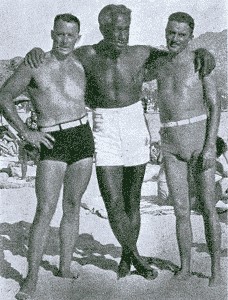 |
(Tom Meager, Bondi, and Clem Morath, Freshwater) |
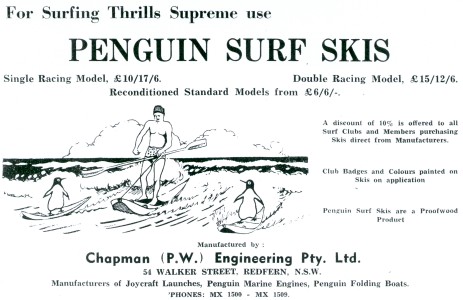 |
Penguin Surf Skis Chapman Engineering 54 Walker Street redfern. Phones: MX 1500 MX 1509. SLSAA: Surf in
Australia
|
Chorus:
Then it's swim,
boys, swim,
With belt and
board and vim,
For "Vigilance
and Service" is our motto and our song!
Then it's row,
boys, row,
And we'll let
the chorus go
'Till our voices
ring a hundred thousand strong.
(2)
Up, boys, up!
the reels are spinning!
Down! now the
line is paying out!
Battling onward
speeds the beltman,
Courage conq'ring
ev'ry doubt!
Sons of the Surf,
the boats are launching,
Belts on, we
watch you pull away. ...
Safety now you're
nearing!
Hear the people
cheering
The boys of the
S.L.S.A.!
Chorus:
Then it's swim,
boys, swim,
With belt and
board and vim, etc., etc.
______________
[Listen for the
music at the Bondi Carnival on Dec. 16.
Song and marching
records 7/6 each from Hon. Editor, "Surf in Australia."]
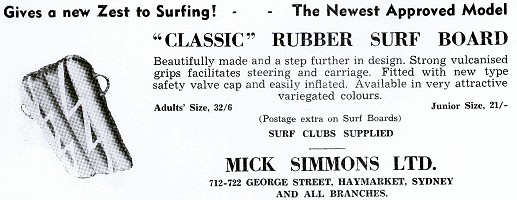
|
Surf in Australia. Official Organ of the Surf Life Saving Association of Australia (Head Centre), 119 Phillip, Street Sydney. Published by Alexander Leo Finn, 149 Dover Road, Rose Bay. Printed by Lake and Ashes Pty Ltd., 389-391 Sussex Street Sydney. 1939. |
 |

| home | catalogue | history | references | appendix |